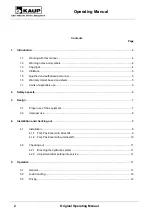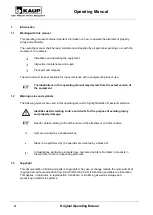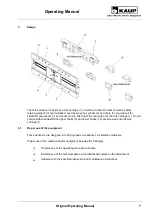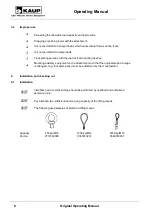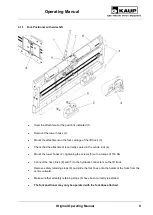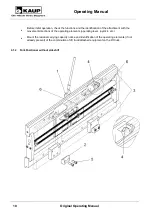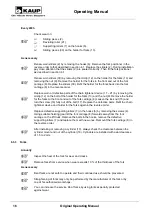
Operating Manual
Original Operating Manual
11
4.2
Checking out
KAUP-attachments are delivered pre-lubricated. If the attachment has been in storage
for a longer period, we recommend that it be lubricated again before being placed in
service. See 6. Maintenance and onwards.
Failure of the safety devices (e.g. the pressure relief valve and the non-return
valve) and incorrect connection of the controls to the actuators can cause
malfunctioning of the attachment and damage to it.
After mounting and before initial operation, check the functions and the
identification of the attached equipment with the movement directions of the
operating elements (operating lever, joystick, etc.).
4.2.1 Bleeding the hydraulic system
Start the lift truck.
Move the sideshifter repeatedly in both directions to maximum extent.
Repeatedly cycle the fork positioner from the fully open to the fully closed position.
Inspect the hydraulic connections for leakage.
4.2.2 Adjustment after putting into service
The hydraulic system is under pressure. During work on hydraulic components
oil spurting out can cause injuries. Unload the system in accordance with the
operating instructions of the lift truck manufacturer. In the case of injuries
caused by high pressure oil, inform the works physician and seek out a
specialist immediately.
5.
Operation
5.1
General
At least once per working shift, the machine and equipment must be inspected for
visible damage and defects.
Repeat faults to your superior and have them rectified without delay.
Be aware of persons present in the area where you are working or driving and ensure
that they are not endangered.
Do not transport any load exceeding that specified on the residual load plate for the
particular combination of lift truck and attachment.
Note the load-bearing capacity of the attachment as stated on the rating plate. This
figure always represents the load carried by two or more fork arms.
The nominal capacity of the forks must exceed the load.


